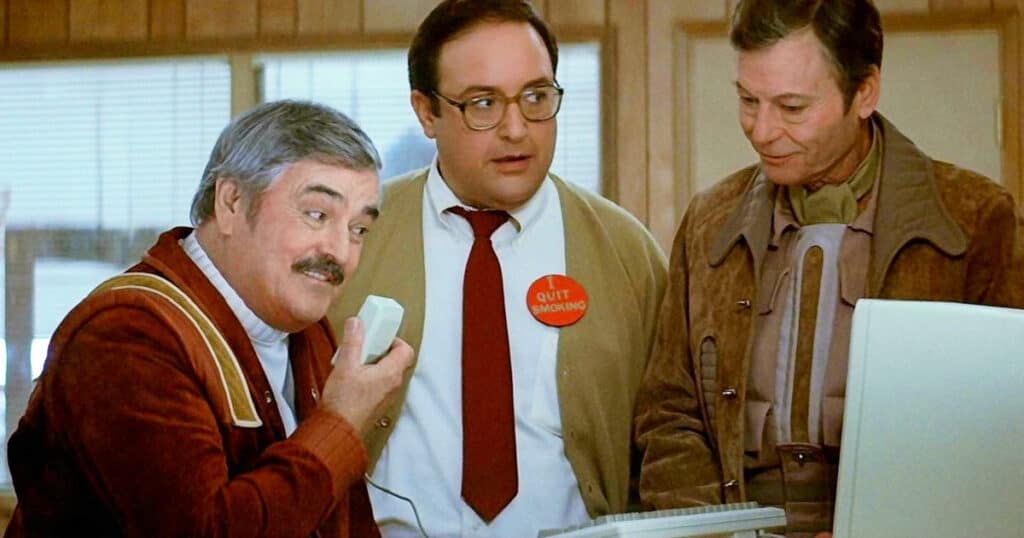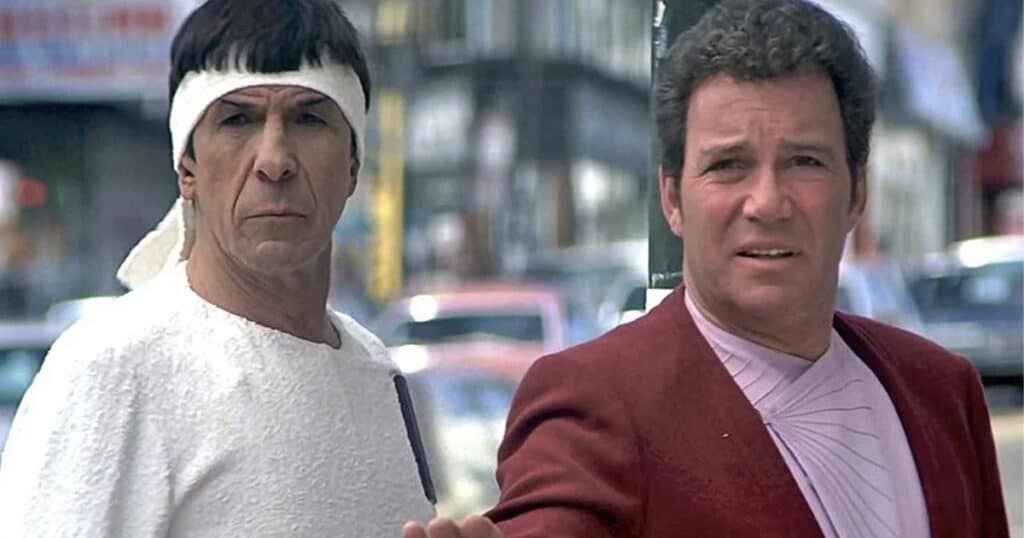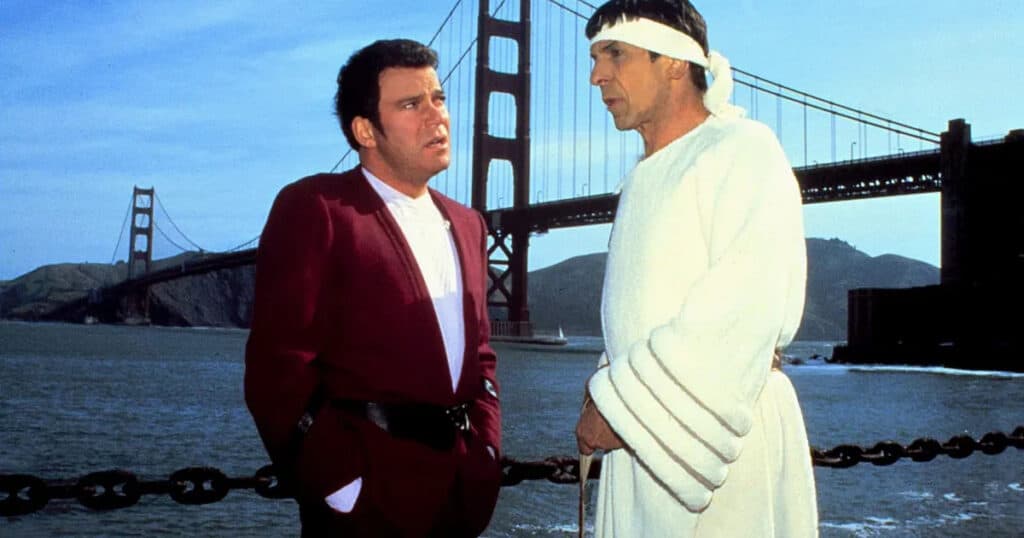In 1984, Leonard Nimoy boldly went where he had never gone before – into the director’s chair of a feature film. His being allowed to direct Star Trek III: The Search for Spock was part of his deal to return to the franchise, as if they had not allowed him this opportunity, the search for Spock might be ended with them… ya know… not finding him. While critics were cool on the film, audiences and fans liked it enough to make it a considerable financial success, earning $76.5 million domestically – just below the $78 million The Wrath of Khan had made. However, like the previous film, its success was limited to North America, with it only making about $10 million internationally compared to the $20 million Wrath of Khan made. No matter, like its predecessor, it was a significant hit on home video and cable, and soon plans were in the works for a fourth film which would retain Nimoy in the director’s chair. But, the director would take the series in a much different direction, emphasizing comedy over action and bringing the cast to the 20th Century. The resulting film would be pricier than usual for a Star Trek movie, but it would be a rare thing for the franchise – an international blockbuster and the highest grossing Trek film of all time – even surpassing Star Trek – The Motion Picture. Yes, folks, the time has come to revisit Star Trek IV: The Voyage Home.
Star Trek II and III were a lot of people’s entry points to the Star Trek franchise. Since starting this series, we’ve had many people tell us via the YouTube comments that those two movies were what made them fall in love with the series. For me, I must admit, it was this fourth film, as it had heavy rotation on pay T.V. when I was a kid, and it was my introduction to the crew of the Enterprise. I saw III and then II soon after, meaning I watched the whole Genesis Trilogy in reverse, although being about six years old at the time, I didn’t even know what a trilogy was. Suffice it to say, the Trek films, thus far, had been blockbusters and made the series cool again. If Star Trek had been airing a lot on T.V. before the films came out, now it was virtually everywhere, and in 1986 the series would be celebrating its 20th anniversary. Paramount Pictures had already been plotting a new Star Trek T.V. series, but it wouldn’t be ready to launch until the following year. But there was no way Paramount wouldn’t have a Trek movie in theatres to celebrate this milestone.
While Paramount had gone into The Wrath of Khan with very little faith in the continued viability of the franchise, by the time IV was kicking off, they were interested in taking it to the next level. Thus the budget was increased significantly, from Star Trek III’s $16 million to $26 million for The Voyage Home. They would need to make a very commercial movie to make ends meet, and Paramount had an ace up its sleeve. Eddie Murphy. At the time, Murphy was the biggest star on the Paramount lot, having starred in 48 HRS., Trading Places and Beverly Hills Cop. As it turns out, Murphy was a huge Star Trek fan and wanted to be in one of the movies. Producers Harve Bennett and Leonard Nimoy had already decided to make this a lighter movie without a villain. Taking a page from the classic episode The City on the Edge of Forever, it would be a time travel story.
The writer of Beverly Hills Cop, Daniel Petrie Jr, was brought on to develop a script that could believably work as both a Star Trek and Eddie Murphy movie. The choice was made to have the crew travel back to San Francisco in the 20th Century. Nimoy chose to give the film an ecological message inspired by the plight of the humpback whales who were being hunted to extinction by whalers. People may view this as heavy-handed now, but I can tell you that every kid who saw this movie had nightmares about whales being murdered, and indeed they were almost extinct at the time the movie was made, only numbering about 5000 in the world. Now, they’re back up to 135,000. I don’t want to say that Leonard Nimoy literally saved the whales, but, ya know, he didn’t NOT save the whales either.

In the original script, Murphy was set to play a college professor obsessed with two things – aliens and whales – leading to him helping the Enterprise crew in their quest, which is to bring back a humpback whale to the 23rd Century in order to speak to a deadly probe that only communicates in whale song.
In the end, cooler heads prevailed. It occurred to everyone that bringing Murphy into Trek was risky. Yes, it could theoretically greatly increase the Trek audience, but it would mean limited screen time for the crew and limited time for Murphy too. It wouldn’t be a Star Trek movie, and it wouldn’t really be an Eddie Murphy movie, either. It would be too much like Superman III, where the movie became a toned-down Richard Pryor comedy. Murphy himself said his issue was that he didn’t want to play an “Eddie Murphy-type” but rather wanted to be up on the ship with the crew and not, as he put it, “talking jive to Spock.” Murphy opted to make The Golden Child instead, which, naturally, was a smash hit, and he went on to make a bunch more huge movies all throughout the eighties. Murphy, for his part, always maintained his love of Trek, with him joking about it in his stand-up, watching it in Boomerang, where he proudly tells Halle Berry’s character that he’s a Trekkie.

They ended up turning to Nicholas Meyer, who had basically saved the franchise with Star Trek II, to retool the script with Harve Bennett, leading to the version that went into production. The proposed Eddie Murphy character was turned into a female marine biologist to be played by Catherine Hicks, who would serve as a love interest, to some extent, for Kirk. Meyer proved to be the ideal guy to write a time travel comedy, as he had made Time After Time and mined a lot of laughs out of HG Wells travelling to 20th Century San Francisco.
Indeed, the movie unexpectedly turned into something of a laugh riot. No one ever thought a Star Trek movie could be legitimately funny, but the fish-out-of-water aspect was done brilliantly, with Kirk and Spock travelling through San Francisco, learning to swear, assaulting annoying punk rockers, and basically having a good old time. Trivia – the pub rocker is played by the movie’s associate producer Kirk Thatcher, who also wrote the song “I Hate You”with sound designer Mark Mangin.i Everyone has fun, with Walter Koenig’s Chekov getting into trouble for infiltrating a nuclear base because, well, he’s Russian and this was the Cold War after all. The only issue is that the movie centres so heavily around Kirk and Spock that everyone else is sidelined to some degree. However, Deforest Kelly, as McCoy, gets a few good moments when he visits a “barbaric” 20th-century hospital, even giving an old woman on dialysis a few pills that grow him a new set of kidneys.
The resulting film would actually have a lot in common with another big hit Paramount made in 1986, Crocodile Dundee. Fish out of water was a formula that really worked for them. One thing fans have noted about The Voyage Home is that the musical score is a major departure from what James Horner did in Star Trek 2 and 3. Apparently, Nimoy wanted him back, but at this point, Horner had become a top composer and opted to score movies like Aliens. Thus, Leonard Rosenman, who had a lot of sci-fi credits, including Fantastic Voyage and a few of the Planet of the Apes sequels, was brought in. The film was so well-received that Rosenman earned an Academy Award nomination for his score.

Indeed, the film was a resounding success at the box office, striking just the right chord with audiences, from its opening dedication to the crew of the U.S.S. Challenger, a disaster that happened in January that year right through to the end credits. Fans liked it too, with it continuing the arc set up by the other two movies centring around Spock’s death and rebirth, while Kirk gets his groove back by shirking duty to save his friend, and being “punished” by a demotion from Admiral to Captain, something he embraces wholeheartedly. The movie also sets up a plot thread that pays off in Star Trek VI, in which Kirk is now considered an enemy of the Klingon empire, setting up a JFK-ish plot in that final film in the O.G. cast franchise.
Star Trek IV: The Voyage Home opened in theatres over Thanksgiving weekend, a shrewd move by the studio as it opened the saga up to a family audience. It grossed $109 million domestically and even did well overseas, being the first Trek film shown in the Soviet Union. It was an even bigger hit on home video and, notably, was one of the first films to be released in the letterboxed format when the studio eventually did a director’s series. The home video launch also coincided with two more lucrative events for the franchise. One, it hit stores just before Star Trek: The Next Generation premiered, and, wouldn’t you know it, every home video contained an ad for the syndicated show. Paramount also started issuing the Original Series on VHS, which was unique as not many tv shows had been released that way. It was a pioneering success.
Probably the one to benefit from the movie’s crossover success the most was Leonard Nimoy, who all of a sudden was looked at as a legit director with a lot of talent as far as comedy went. His follow-up, Three Men and a Baby, would be the biggest hit of 1987. Of course, William Shatner couldn’t help but take note and, indeed, when Star Trek V: The Final Frontier came out, Shatner himself would trade the captain’s chair for a director’s chair. The resulting film would almost crater the film franchise for good, but that’s a story for another time!
Originally published at https://www.joblo.com/star-trek-iv-the-voyage-home-revisited/

